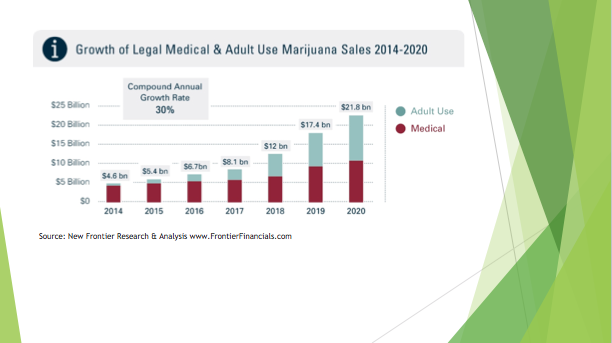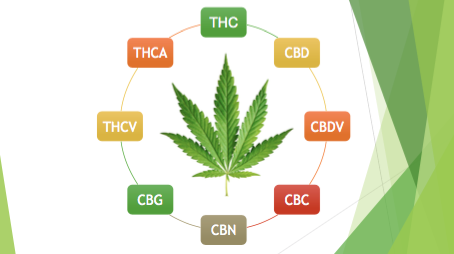The History, The Plant, The Benefits of Marijuana: Part 1 of ‘Investing In the Legal Cannabis Industry’ webinar from Retirement Loft
Jay and Diane speak with Tom Garlock of Retirement Lofts regarding Marijuana as a big opportunity for growing retirement portfolios as the industry takes off. Watch the video below, and scroll down to read the transcription.
“Welcome to the Retirement Loft Investment Spotlight Series, where we explore ways to improve your financial results and help you grow your retirement portfolio. This is Tom Garlock. Thanks for joining us today. I’m really excited about today’s topic. In America today, marijuana by all estimates is a $50 billion industry. Of that total, only $5 billion dis sold legally. The other $45 billion is part of the illegal black market. In other words, only 10% of the $50 billion market has been tapped, but that is changing rapidly. Let’s go ahead and get started.
First, a couple disclosure items. Today’s presentation is pure educational. There are no investments being offered here today. Before you make any investments in this industry, you’ve got to seek out advice from experts who can explain the risk factors to you. To help you begin your research on the cannabis industry, we’ve prepared several reports that you’ll be able to access at the end of today’s webinar.
Before I introduce our special guests, here are two quick charts that I think you’ll find amazing.
A single acre of land can produce over $1 million of marijuana each year.
That same acre only produces $645.00 of corn, $403.00 of soybeans, and about half of that amount for wheat. Now, I’m sure the million-dollar yield per acre will come down over the next five years, but this is America’s most profitable crop right now.
 The next slide shows you what many believe the growth rate will be out into the future. It’s projected that there’ll be over $20 billion of legal cannabis sales by the year 2020, and I’ve recently heard some forecasts of $100 billion over the next ten years.
The next slide shows you what many believe the growth rate will be out into the future. It’s projected that there’ll be over $20 billion of legal cannabis sales by the year 2020, and I’ve recently heard some forecasts of $100 billion over the next ten years.
With that, it’s my pleasure and honor to introduce our speakers today, Diane and Jay Czarkowski of Canna Advisors. Diane and Jay are true pioneers in this industry. I’ll ask them to share their background with you. Diane and Jay, thank you very much for taking time out of your busy schedule today to speak with us. Please start with your story. I’m dying to have you share your background and story with the audience.
Well, Tom, thanks for having us today. We’re excited to be here and help impart some of our knowledge in what is certainly clearly at this point America’s next great industry. Diane and I got involved in the cannabis industry back in 2009, almost seven years ago, during almost the height of our nation’s financial collapse. We had some real estate in Boulder, Colorado, that we were looking to lease out. There was a couple of groups of young folks that approached us. They all had cash, told us they wanted to open a dispensary. Had no idea this was going on, but that’s what gave us the idea almost seven years ago, and took the idea and ran with it.
We actually secured City of Boulder, Colorado, marijuana license number one and State of Colorado marijuana license number seven years ago.
Three years ago, we began to branch out and work with likeminded folks in other states, good businesspeople in other states across the country as those states began to pass medical marijuana or rec laws.
At this point, we have worked with groups in other states and we have successfully secured competitive licenses in Connecticut, Massachusetts, Nevada, Illinois, Canada. We’re anxiously awaiting on the results in Maryland and Hawaii at this point. Three years into having a cannabis consulting and services company, we’ve helped dozens of groups secure licenses and set up operations. And we’re certainly very bullish about the future, as this industry is clearly expected to grow fourfold just in the next few years.
I’m going to start talking about the history of the cannabis plant.
Because since it’s been prohibited for most of our lives today, many people are just not familiar with it. It’s actually been woven into our history book since ancient history, and we’ve had prescribed medical uses of this plant for more than 2700 years. 1500 BC was the earliest written reference to medical marijuana in Chinese pharmacopoeia, and we also know that Queen Victoria used to use it for migraines and menstrual cramps. Our forefathers Thomas Jefferson and George Washington were prolific hemp farmers, and just recently, we discovered the evidence that Shakespeare smoked it in its pipe.
It was a really common ingredient in our pharmacopoeia in the 1800s and early 1900s, and makers like Park Davis marketed it as a cure for everything from coughs to corns.
Botanists are still trying to determine if the plant has three species or if it’s one species with three subspecies.
The species are called cannabis sativa, cannabis indica, and cannabis ruderalis.
You might also question, “What about hemp?” Hemp is actually a variety of the cannabis sativa plant. It just has less than 1% of THC, which is the only psychotropic cannabinoid or compound within the plant. Both hemp and marijuana come from the same species, but they’re genetically distinct and they’ve been further differentiated by the way that they’ve been cultivated and the chemical makeup of the plants.
One of the things that I love about the cannabis plant is that you can use every part of it.
The stems are very fibrous and have often been bred so that they have very long stalks or stems for industrial and commercial purposes. The leaves are often used for extractions and oil, and then there are the flowers.
Now, the flowers in hemp are used to produce hemp seeds, and that’s one of the most nutrient-dense foods in the planet. It’s medical and it also, used in the cannabis industry, has the most value in the medical terms from the flower. This picture here depicts a mature flower that we use in the medical marijuana industry, and if you were to see up close to this flower, you would see a lot of crystal-like shiny parts on the flower. Those are called trichomes. They’re actually filled with a resin that’s rich in cannabinoids.
 Cannabinoids are compounds that are found within the plant. You’re probably familiar with THC, which is the only psychotropic cannabinoid found in the plant, and you may also be familiar with CBD, as that’s been getting a lot of press recently because of its effective treatment for seizure disorders. There’s more than 80 cannabinoids that have been identified in the plant. Research is showing that there’s a greater effect when the cannabinoids are allowed to work together, and that’s called the “entourage effect.” For example, if you take a combination of THC and CBD together, they’re very effective when treating things like seizure disorders. If you take CBD and CBN together, that’s very effective for anti-insomnia. CBG and THC work really great together in treating nerve and neurological damage.
Cannabinoids are compounds that are found within the plant. You’re probably familiar with THC, which is the only psychotropic cannabinoid found in the plant, and you may also be familiar with CBD, as that’s been getting a lot of press recently because of its effective treatment for seizure disorders. There’s more than 80 cannabinoids that have been identified in the plant. Research is showing that there’s a greater effect when the cannabinoids are allowed to work together, and that’s called the “entourage effect.” For example, if you take a combination of THC and CBD together, they’re very effective when treating things like seizure disorders. If you take CBD and CBN together, that’s very effective for anti-insomnia. CBG and THC work really great together in treating nerve and neurological damage.
Why is this cannabis plant so effective?
 It’s because we have an endocannabinoid system. Think of it as receptors that connect with the cannabinoids in the plant. These are concentrated in different areas of our bodies. That’s why it’s used for treating so many different conditions.
It’s because we have an endocannabinoid system. Think of it as receptors that connect with the cannabinoids in the plant. These are concentrated in different areas of our bodies. That’s why it’s used for treating so many different conditions.
It’s often used as a bone stimulant; an anti-emetic, which reduces nausea; an anti-epileptic, which is great because one in 26 Americans has some type of epilepsy, and most of those are actually children. It’s very effective in being an anti-depressant, which affects close to 350 million people worldwide, and it’s very effective with anti-insomnia, which affects one in three people, or over 60 million Americans. As you look at these things, you can probably think of someone who would probably benefit from this plant.
It’s estimated that over 300 million people today use medical marijuana.”
The original webinar from Retirement Lofts can be found here.